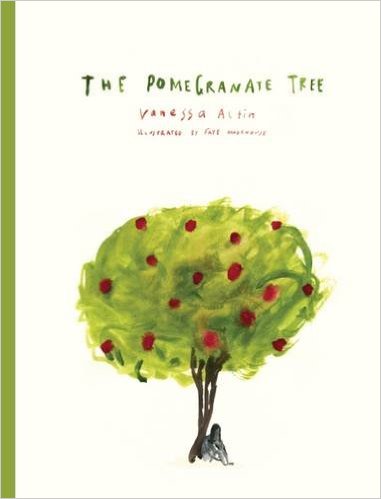Inspiring Young Readers
 posted on 10 Mar 2016
posted on 10 Mar 2016
The Pomegranate Tree by Vanessa Altin
Vanessa Altin is a tabloid journalist and she intended this to be a shocking book which should be read by teenagers as a way of waking them up to what is happening in Syria. It is based on her personal experience of visiting the town of Suruc, the last town in Syria before the Turkish border, with her Kurdish husband and where she was horrified by the scores of children who had been separated from their family by the events of the war. Here she heard many stories of atrocities and was particularly haunted by a photo of a baby about to be beheaded. This ghastly image is one of the first memories of the thirteen year old Dilly ( based on a real girl that the author met on her journey) whose journal is the basis for the story. In this case it is her little sister at the hands of one of what she describes as 'the ratmen' who seem to take sadistic delight in torture and killing. Dilly is separated from her mother and two sisters and left behind with an older girl Rehana who turns out to be a member of the Kurdish fighting force. She is the reason behind the journal being written as she persuades Dilly that this is a good way of capturing her happy memories and also documenting the progress of the war for others to read.
The journal is poignant to read because it begins by looking back at a time before the war when the family lived an ordinary uneventful life. We have many glimpses of a happy childhood with memories of long hours playing in the beautiful natural environment. The references to family stories about Dilly's own mother's childhood in the mountains living simply with her father, a shepherd and his troupe of huge working dogs emphasises the sense of generations of peace before the war. The importance of food and drink is threaded through the whole journal with the delectable taste and jewel-like appearance of pomegranate seeds being used as example of sensuous pleasure as well as a more profound symbol of hope - hence the title of the book.
We learn that when Dilly's father and five older brothers left the town some months before to fight the enemy the mother and remaining three sisters were full of sorrow, tempered by fierce pride and admiration. The writer does not pull back from describing how civil war drives people of all ages to want to despise and to ultimately kill the enemy. This furious hatred felt by Dilly, family and friends is visceral and makes a lot of sense. In her eyes, these men are no longer human because of their despicable behaviour and so deserve no sympathy. She compares them to the Dementors in the Harry Potter books and this justifies her cold and triumphant reaction when any are killed. There is plenty of slaughter described in a matter of fact way throughout the book and Rehana is regarded as a local celebrity partly because she has reached a tally of killing 100 terrorists.
I couldn't help but compare this book to The Diary of Ann Frank, another young girl's record of everyday life in a time of war. Perhaps this is unfair because that was an authentic journal that wasn't intended to be widely read. It was about an imprisoned family trying to rub along together under extraordinary circumstances rather than learning to live separately. This journal has a very different more deliberate voice written by an adult who is trying to help the intended readers understand the complexity of war and the way one girl deals with long separation, fear and optimism for the future. Although I am reasonably aware of the current situation in Syria, it certainly gave me further food for thought.
I think that the author has succeeded in mixing polemic with a well-paced and eventful narrative. Dilly is an example of a spirited and likeable young woman who on the one hand wants desperately to be part of the armed struggle for freedom but on the other hand yearns to return to the ordinary life of a thirteen year old who is cherished by her parents, siblings and community. Altin has explained that she wanted to write a hopeful life affirming story with strong resilient characters in the tradition of books that had inspired her as a young reader, like The Railway Children, Pollyanna and Swallows and Amazons. As with these well-loved stories, terribly difficult things happen along the way but there is a generally positive ending.
I do have one minor criticism: reading and enjoying any book is influenced by the quality of the paper and the size of the print. It is a shame that this one was, for me, relatively poor in design which interfered a bit with the overall experience. Despite this I was certainly drawn in and fascinated from the start and I also think that the smudgy watercolour illustrations by Faye Moorhouse featured throughout added to the texture of the story.
I strongly recommend that you should read this memorable book which presents one Syrian childhood seriously blighted by war but it is also a childhood that has many familiar echoes, which makes it all the more chilling to read about.
Karen Argent
9th March 2016